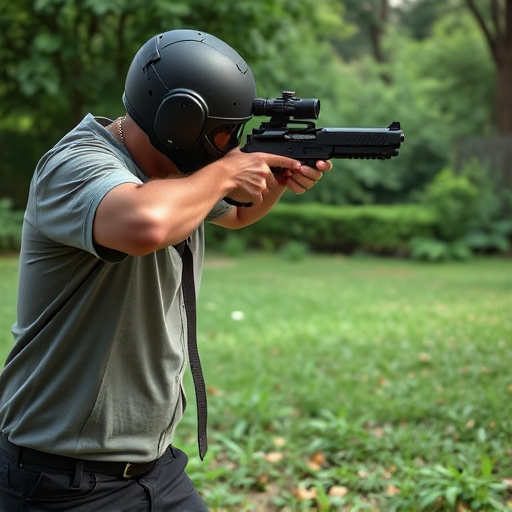OC spray effectiveness and safety depend on capsaicin concentration levels, ranging from 0.5% to 2%. Lower concentrations are used for minimal irritation, while higher levels (3%-5%) are for specialized tactical situations. Law enforcement officers should understand these levels to choose the optimal OC spray for crowd control and operational safety, following training protocols and adherence to guidelines based on capsaicin concentration levels.
“Discover the powerful tool that is pepper spray, specifically focusing on its role in law enforcement. This comprehensive guide explores the science behind OC spray and its capsaicin concentration levels, offering insights into how these chemical compounds pack a punch. From understanding the weaponry’s potential to training protocols, we delve into the safety and effectiveness of OC spray for law enforcement. Learn about measuring potency, ensuring safe handling, and mastering its use in diverse scenarios.”
- OC Spray: Understanding Capsaicin Concentration
- Law Enforcement's Pepper Spray Weaponry
- Measuring OC Spray Potency and Safety
- Effective Use and Training Protocols
OC Spray: Understanding Capsaicin Concentration
OC spray, a common less-lethal weapon used by law enforcement, operates by delivering capsaicin, the active ingredient found in chili peppers, into the eyes and respiratory system of a target. The effectiveness and safety of OC spray heavily depend on its capsaicin concentration levels. These concentrations are typically measured in percent or parts per million (ppm). Standard OC spray solutions usually contain between 1% and 2% capsaicin, offering a balanced force for crowd control while minimizing the risk of permanent injury.
Higher concentration levels, ranging from 3% to 5%, are reserved for specialized tactical situations where enhanced potency is required. Conversely, lower concentrations, such as 0.5%, are employed in scenarios demanding minimal irritation and rapid de-escalation. Understanding capsaicin concentration levels allows law enforcement officers to select the most appropriate OC spray for specific duties, ensuring both effectiveness in crowd control and operational safety.
Law Enforcement's Pepper Spray Weaponry
Law enforcement agencies worldwide have long relied on pepper spray as a crucial non-lethal weapon to subdue and control suspects. Known for its effectiveness in disabling individuals temporarily, pepper spray is a powerful tool in law enforcement strategy. At the heart of this technology is capsaicin, the active ingredient responsible for the burning sensation associated with chili peppers. The potency of this chemical is measured in OC (Oleoresin Capsaicin) spray capsicum concentration levels, typically ranging from 1% to 2%.
These concentrations are determined by the intended use and the specific requirements of different jurisdictions. Law enforcement officers carry pepper spray in various forms, including aerosol cans and foam formulations, each designed for optimal range, duration, and impact. The strategic deployment of pepper spray during tactical situations allows officers to control and immobilize suspects, providing valuable time for backup or further containment measures. With ongoing developments in formulation and delivery systems, OC spray continues to evolve as a critical tool in modern law enforcement arsenal.
Measuring OC Spray Potency and Safety
Law enforcement grade pepper spray weapons are designed to incapacitate individuals through the use of capsaicin, a chemical compound derived from chili peppers. Measuring OC spray potency and safety is paramount for ensuring effectiveness and mitigating risks. The primary metric here is the oc spray capsicum concentration levels, which indicate the amount of capsaicin in the solution. This concentration is typically measured in parts per million (ppm).
Manufacturers often provide guidelines on optimal usage based on these capsaicin concentration levels. Safety protocols mandate that officers receive adequate training to deploy the spray responsibly. Additionally, regular testing and maintenance ensure that the pepper spray remains potent over time while adhering to safety standards. Such measures are crucial for maintaining public safety during law enforcement operations.
Effective Use and Training Protocols
The effective use of pepper spray by law enforcement involves understanding its unique properties and adhering to rigorous training protocols. OC (Oleoresin Capsaicin) spray, with its capsaicin concentration levels varying from 1% to 2%, is designed to incapacitate an individual temporarily by causing a burning sensation in the eyes, nose, and respiratory system. Effective use requires officers to aim for the face, maintain a safe distance, and activate the spray for only as long as necessary to subdue the subject.
Training protocols should cover not just the technical aspects of spraying but also de-escalation techniques and situational awareness. Officers must learn to recognize signs of distress or resistance in suspects and adapt their approach accordingly. Regular simulations and scenarios help prepare them for real-world situations, ensuring they use pepper spray responsibly and proportionately while prioritizing safety for both the officers and the public.
Pepper spray, or OC spray, is a powerful law enforcement tool that utilizes capsaicin concentration levels to incapacitate individuals. Understanding the dynamics of capsaicin and its effects is crucial for effective deployment and safety measures. By measuring and regulating OC spray potency, law enforcement agencies can ensure optimal performance while minimizing risks. Proper training protocols are essential to empower officers with the skills to use this weapon effectively, balancing force with public safety in every situation.
